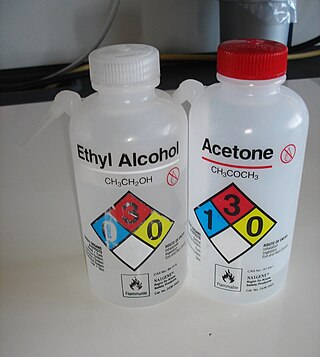This article needs to be updated.(August 2021) |
A highly hazardous chemical, also called a harsh chemical, is a substance classified by the American Occupational Safety and Health Administration as material that is both toxic and reactive and whose potential for human injury is high if released. Highly hazardous chemicals may cause cancer, birth defects, induce genetic damage, cause miscarriage, injury and death from relatively small exposures.
Highly hazardous chemicals include:
| Chemical | CAS number | Threshold quantity (lbs) |
|---|---|---|
| Acetaldehyde | 75-07-0 | 2500 |
| Acrolein | 107-02-8 | 150 |
| Acryloyl chloride | 814-68-6 | 250 |
| Allyl chloride | 107-05-1 | 1000 |
| Allylamine | 107-11-9 | 1000 |
| Alkylaluminum | Varies | 5000 |
| Ammonia, anhydrous | 7664-41-7 | 10000 |
| Ammonia solutions (greater than 44% ammonia by weight) | 7664-41-7 | 15000 |
| Ammonium perchlorate | 7790-98-9 | 7500 |
| Ammonium permanganate | 7787-36-2 | 7500 |
| Arsine | 7784-42-1 | 100 |
| Bis(chloromethyl) ether | 542-88-1 | 100 |
| Boron trichloride | 10294-34-5 | 2500 |
| Boron trifluoride | 7637-07-2 | 250 |
| Bromine | 7726-95-6 | 1500 |
| Bromine chloride | 13863-41-7 | 1500 |
| Bromine pentafluoride | 7789-30-2 | 2500 |
| Bromine trifluoride | 7787-71-5 | 15000 |
| 3-Bromopropyne | 106-96-7 | 100 |
| tert-Butyl hydroperoxide | 75-91-2 | 5000 |
| tert-Butyl perbenzoate | 614-45-9 | 7500 |
| Carbonyl chloride | 75-44-5 | 100 |
| Carbonyl fluoride | 353-50-4 | 2500 |
| Cellulose nitrate (concentration greater than 12.6% nitrogen) | 9004-70-0 | 2500 |
| Chlorine | 7782-50-5 | 1500 |
| Chlorine dioxide | 10049-04-4 | 1000 |
| Chlorine pentafluoride | 13637-63-3 | 1000 |
| Chlorine trifluoride | 7790-91-2 | 1000 |
| Chlorodiethylaluminum | 96-10-6 | 5000 |
| 1-Chloro-2,4-dinitrobenzene | 97-00-7 | 5000 |
| Chloromethyl methyl ether | 107-30-2 | 500 |
| Chloropicrin | 76-06-2 | 500 |
| Chloropicrin and methyl bromide mixture | None | 1500 |
| Chloropicrin and methyl chloride mixture | None | 1500 |
| Cumene hydroperoxide | 80-15-9 | 5000 |
| Cyanogen | 460-19-5 | 2500 |
| Cyanogen chloride | 506-77-4 | 500 |
| Cyanuric fluoride | 675-14-9 | 100 |
| Diacetyl peroxide (concentration greater than 70%) | 110-22-5 | 5000 |
| Diazomethane | 334-88-3 | 500 |
| Dibenzoyl peroxide | 94-36-0 | 7500 |
| Diborane | 19287-45-7 | 100 |
| tert-Dibutyl peroxide | 110-05-4 | 5000 |
| Dichloroacetylene | 7572-29-4 | 250 |
| Dichlorosilane | 4109-96-0 | 2500 |
| Diethylzinc | 557-20-0 | 10000 |
| Disopropyl peroxydicarbonate | 105-64-6 | 7500 |
| Dilauroyl peroxide | 105-74-8 | 7500 |
| Dimethyldichlorosilane | 75-78-5 | 1000 |
| 1,1-Dimethylhydrazine | 57-14-7 | 1000 |
| Dimethylamine, anhydrous | 124-40-3 | 2500 |
| 2,4-Dinitroaniline | 97-02-9 | 5000 |
| Ethyl nitrite | 109-95-5 | 5000 |
| Ethylamine | 75-04-7 | 7500 |
| Ethylene fluorohydrin | 371-62-0 | 100 |
| Ethylene Oxide | 75-21-8 | 5000 |
| Ethyleneimine | 151-56-4 | 1000 |
| Fluorine | 7782-41-4 | 1000 |
| Formaldehyde (formalin) | 50-00-0 | 1000 |
| Furan | 110-00-9 | 500 |
| Hexafluoroacetone | 684-16-2 | 5000 |
| Hydrochloric acid, anhydrous | 7647-01-0 | 5000 |
| Hydrofluoric acid, anhydrous | 7664-39-3 | 1000 |
| Hydrogen bromide | 10035-10-6 | 5000 |
| Hydrogen chloride | 7647-01-0 | 5000 |
| Hydrogen cyanide, anhydrous | 74-90-8 | 1000 |
| Hydrogen fluoride | 7664-39-3 | 1000 |
| Hydrogen peroxide (52% by weight or greater) | 7722-84-1 | 7500 |
| Hydrogen selenide | 7783-07-5 | 150 |
| Hydrogen sulfide | 7783-06-4 | 1500 |
| Hydroxylamine | 7803-49-8 | 2500 |
| Iron pentacarbonyl | 13463-40-6 | 250 |
| Isopropylamine | 75-31-0 | 5000 |
| Ketene | 463-51-4 | 100 |
| Methacrylaldehyde | 78-85-3 | 1000 |
| Methacryloyl chloride | 920-46-7 | 150 |
| Methacryloyloxyethyl isocyanate | 30674-80-7 | 100 |
| Methyl acrylonitrile | 126-98-7 | 250 |
| Methylamine, anhydrous | 74-89-5 | 1000 |
| Methyl bromide | 74-83-9 | 2500 |
| Methyl chloride | 74-87-3 | 15000 |
| Methyl chloroformate | 79-22-1 | 500 |
| Methyl ethyl ketone peroxide | 1338-23-4 | 5000 |
| Methyl fluoroacetate | 453-18-9 | 100 |
| Methyl fluorosulfate | 421-20-5 | 100 |
| Methyl hydrazine | 60-34-4 | 100 |
| Methyl iodide | 74-88-4 | 7500 |
| Methyl isocyanate | 624-83-9 | 250 |
| Methyl mercaptan | 74-93-1 | 5000 |
| Methyl vinyl ketone | 79-84-4 | 100 |
| Methyltrichlorosilane | 75-79-6 | 500 |
| Nickel carbonyl | 13463-39-3 | 150 |
| Nitric acid (94.5% by weight or greater) | 7697-37-2 | 500 |
| Nitric oxide | 10102-43-9 | 250 |
| para-Nitroaniline | 100-01-6 | 5000 |
| Nitromethane | 75-52-5 | 2500 |
| Nitrogen dioxide | 10102-44-0 | 250 |
| Nitrogen oxides (NO; NO2; N2O4; N2O3) | 10102-44-0 | 250 |
| Nitrogen tetroxide | 10544-72-6 | 250 |
| Nitrogen trifluoride | 7783-54-2 | 5000 |
| Nitrogen trioxide | 10544-73-7 | 250 |
| Oleum (65% to 80% by weight) | 8014-95-7 | 1000 |
| Osmium tetroxide | 20816-12-0 | 100 |
| Oxygen difluoride | 7783-41-7 | 100 |
| Ozone | 10028-15-6 | 100 |
| Pentaborane | 19624-22-7 | 100 |
| Peracetic acid (concentration greater than 60%) | 79-21-0 | 1000 |
| Perchloric acid (concentration greater than 60% by weight) | 7601-90-3 | 5000 |
| Perchloromethyl mercaptan | 594-42-3 | 150 |
| Perchloryl fluoride | 7616-94-6 | 5000 |
| Phosgene | 75-44-5 | 100 |
| Phosphine | 7803-51-2 | 100 |
| Phosphorus oxychloride | 10025-87-3 | 1000 |
| Phosphorus trichloride | 7719-12-2 | 1000 |
| Phosphoryl chloride | 10025-87-3 | 1000 |
| Propargyl bromide | 106-96-7 | 100 |
| Propyl nitrate | 627-3-4 | 2500 |
| Sarin | 107-44-8 | 100 |
| Selenium hexafluoride | 7783-79-1 | 1000 |
| Stibine | 7803-52-3 | 500 |
| Sulfur dioxide (liquid) | 7446-09-5 | 1000 |
| Sulfur pentafluoride | 5714-22-7 | 250 |
| Sulfur tetrafluoride | 7783-60-0 | 250 |
| Sulfur trioxide | 7446-11-9 | 1000 |
| Sulfuric anhydride | 7446-11-9 | 1000 |
| Tellurium hexafluoride | 7783-80-4 | 250 |
| Tetrafluoroethylene | 116-14-3 | 5000 |
| Tetrafluorohydrazine | 10036-47-2 | 5000 |
| Tetramethyl lead | 75-74-1 | 1000 |
| Thionyl chloride | 7719-09-7 | 250 |
| Trichloro(chloromethyl)silane | 1558-25-4 | 100 |
| Trichloro(dichlorophenyl)silane | 27137-85-5 | 2500 |
| Trichlorosilane | 10025-78-2 | 5000 |
| Trifluorochloroethylene | 79-38-9 | 10000 |
| Trimethoxysilane | 2487-90-3 | 1500 |









